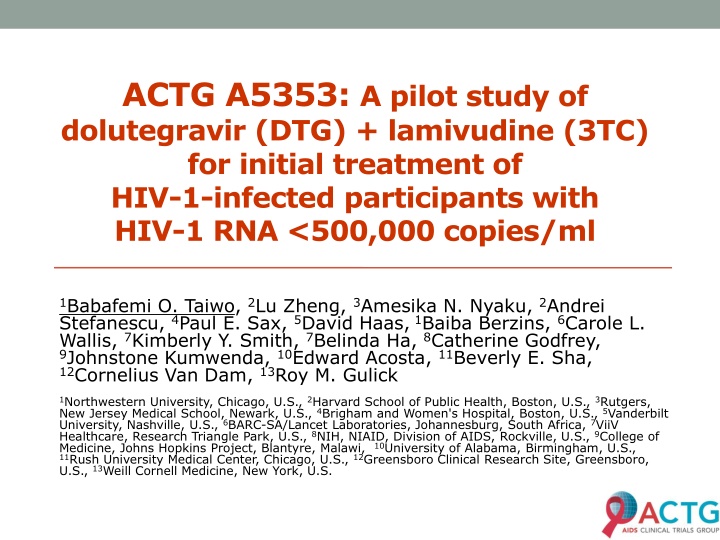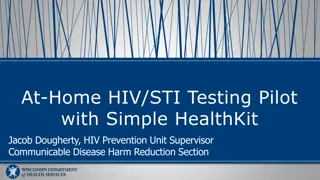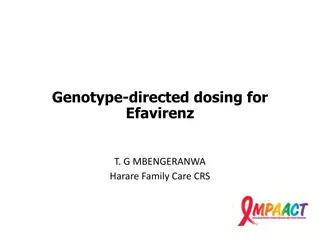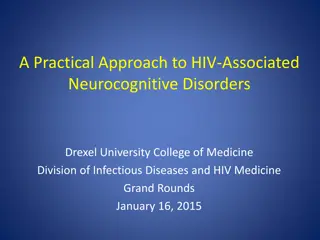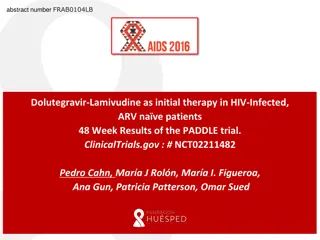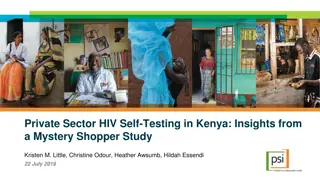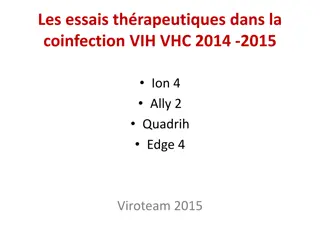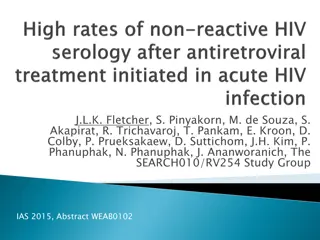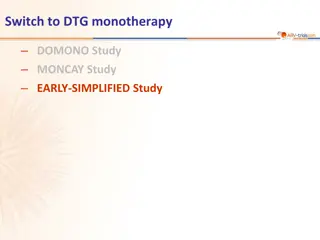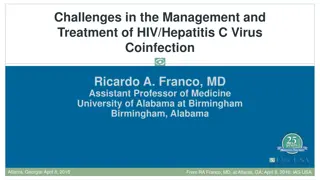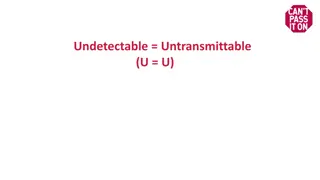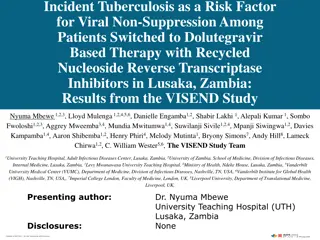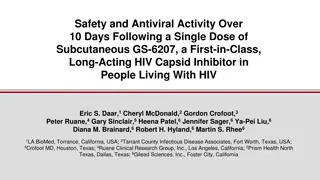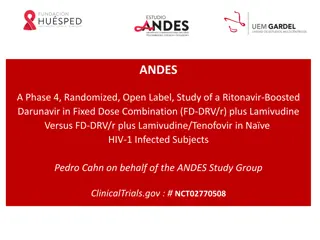Pilot Study of Dolutegravir and Lamivudine for HIV-1 Treatment
Investigating the efficacy of a dolutegravir and lamivudine regimen for initial treatment of HIV-1 participants with low viral loads. The study explores the potential benefits and drawbacks of this regimen, highlighting strengths like robust resistance profiles of dolutegravir and potential cost-saving implications. The PADDLE pilot study showed promising results, with most participants achieving undetectable viral loads. However, the study also identified limitations such as small sample size and exclusion criteria based on baseline viral load and CD4 count. Overall, this research aims to inform future treatment approaches for HIV-1 infection.
Download Presentation

Please find below an Image/Link to download the presentation.
The content on the website is provided AS IS for your information and personal use only. It may not be sold, licensed, or shared on other websites without obtaining consent from the author.If you encounter any issues during the download, it is possible that the publisher has removed the file from their server.
You are allowed to download the files provided on this website for personal or commercial use, subject to the condition that they are used lawfully. All files are the property of their respective owners.
The content on the website is provided AS IS for your information and personal use only. It may not be sold, licensed, or shared on other websites without obtaining consent from the author.
E N D
Presentation Transcript
ACTG A5353: A pilot study of dolutegravir (DTG) + lamivudine (3TC) for initial treatment of HIV-1-infected participants with HIV-1 RNA <500,000 copies/ml 1Babafemi O. Taiwo, 2Lu Zheng, 3Amesika N. Nyaku, 2Andrei Stefanescu, 4Paul E. Sax, 5David Haas,1Baiba Berzins, 6Carole L. Wallis, 7Kimberly Y. Smith, 7Belinda Ha, 8Catherine Godfrey, 9Johnstone Kumwenda, 10Edward Acosta, 11Beverly E. Sha, 12Cornelius Van Dam, 13Roy M. Gulick 1Northwestern University, Chicago, U.S., 2Harvard School of Public Health, Boston, U.S., 3Rutgers, New Jersey Medical School, Newark, U.S., 4Brigham and Women's Hospital, Boston, U.S., 5Vanderbilt University, Nashville, U.S., 6BARC-SA/Lancet Laboratories, Johannesburg, South Africa, 7ViiV Healthcare, Research Triangle Park, U.S., 8NIH, NIAID, Division of AIDS, Rockville, U.S., 9College of Medicine, Johns Hopkins Project, Blantyre, Malawi, 10University of Alabama, Birmingham, U.S., 11Rush University Medical Center, Chicago, U.S., 12Greensboro Clinical Research Site, Greensboro, U.S., 13Weill Cornell Medicine, New York, U.S.
Conflict of Interest Disclosure Served as a paid consultant to ViiV Healthcare, GSK, Gilead and Janssen, and received research support through Northwestern University from ViiV, GSK, and Pfizer
Background Dolutegravir (DTG) + Lamvudine (3TC) is an investigational 2 drug regimen. Strengths of DTG + 3TC Two potent, well tolerated drugs Robust resistance profile of DTG no emergent resistance in almost 1400 participants in phase 2/3 trials (48-144 weeks) of DTG + 2NRTIs Potential for co-formulation Possibly reduced risk of cumulative adverse effects Could save $550 million to > $3 billion in ART costs in the US over 5 years2 Unknowns and potential weaknesses Efficacy at baseline VL > 100,000 copies/mL (cpm) Low resistance barrier of 3TC Contraindicated with hepatitis B co-infection Efficacy in compartments (genital, CNS) and pregnancy 1.Giroud P, et al. CID 2016 62(6):784-91
PADDLE A pilot study of DTG 50 mg + 3TC 300 mg daily1 Showed plasma VL < 50 cpm at week 48 in 18/20 participants (1 suicide; 1 protocol defined virologic failure, PDVF) Limitations Small sample size (N=20), single arm Excluded screening VL >100,000 cpm Excluded screening CD4 count < 200 cells/mm3 Data insufficient to justify enrollment of participants with high baseline VL in phase 3 studies Genotyping performed on the participant with PDVF showed no reverse transcriptase (RT) mutations; integrase did not amplify 1. Cahn et al. J Int AIDS Soc 2017; 20(1):1-7
ACTG A5353 Study Design and Objectives Phase II, single-arm, 52-week, study of DTG 50 mg + 3TC 300 mg in treatment-na ve participants with VL 1000 and <500,000 cpm Primary Objective To estimate the virologic success rate at week 24 Key Secondary Objectives Compare efficacy with baseline VL 100,000 vs >100,000 cpm Describe emergent integrase and RT resistance during virologic failure Evaluate safety and tolerability Explore impact of minority drug-resistant variants and drug exposure/adherence on observed outcomes
Key Eligibility Criteria Antiretroviral drug na ve VL 1000 and <500,000 cpm Pre-specified enrollment of 25% with VL >100,000 cpm No evidence of RT, integrase, or major protease resistance mutation Integrase genotyping was performed by the study at screening Negative hepatitis B surface antigen No active/anticipated HCV treatment within study period. HCV infection alone was not exclusionary
Outcome Measures Primary Efficacy Outcome Virologic success at week 24, defined as on-treatment VL < 50 cpm, using the FDA Snapshot definition. Protocol Defined Virologic Failure (PDVF) Definition Confirmed VL >400 cpm at week 16 or 20 or Confirmed VL >200 cpm at/after week 24
Participant Disposition Up to Week 24 165 screened 43 did not enroll 9 genotype failed 14 RNA/lab out of range 9 not willing to enroll 7 screening window expired 4 illness 122 enrolled 2 ineligible and excluded K103N at screening 120 initiated DTG + 3TC 37 > 100,000 copies/mL 83 100,000 copies/mL 4 discontinued study & DTG+3TC before week 24 2 moved out of area 1 incarceration 1 unable to contact 3 discontinued DTG+3TC before week 24 1 pregnancy 1 non-compliance 1 unable to attend clinic
Baseline Characteristics Baseline HIV-1 RNA Category > 100,000 cpm (N=37) 30 (25, 40) <100,000 cpm (N=83) 30 (24, 42) Median (Q1, Q3) Age (years) Male Sex 89% 86% White Non-Hispanic Black Non-Hispanic Hispanic Median (Q1, Q3) <200 Race/Ethnicity 27% 32% 35% 29% 43% 23% CD4 Count (cells/mm3) 350 (173, 458) 30% 413 (328, 671) 6% HIV-1 RNA (log10 cpm) Median (Q1, Q3) 5.23 (5.09, 5.46) 4.23 (3.82, 4.65) 42% 58% -- -- <10,000 10,000 - 99,999 100,000 - 200,000 > 200,000 -- -- (cpm) 62% 38%
Primary Outcome: FDA Snapshot at Week 24 Baseline HIV-1 RNA > 100,000 cpm N=37 Virologic success 33(89%) HIV-1 RNA < 50 cpm [95% CI] [75%,97%] 100,000 cpm N=83 75(90%) [82%,96%] Total N=120 108(90%) [83%,95%] Virologic non-success HIV-1 RNA 50 cpm Discontinued study treatment for other reasons while HIV RNA 50* 3(8%) 3 0 2(2%) 0 2 5(4%) 3 2 No virologic data in window Discontinued study treatment for other reasons # On study but missing data in window 1(3%) 1 6(7%) 5 7(6%) 6 0 1 1 * Poor adherence; # Lost to follow-up, pregnancy [95% Confidence intervals] for proportion of participants with virologic success at Week 24
FDA Snapshot Virologic Non-Success: HIV-1 RNA to Week 24 >100k >100k
Protocol-Defined Virologic Failures (PDVF): HIV-1 RNA and DTG Levels to Week 24 >100k HIV-1 RNA less than limit of detection . No DTG drug level detected. Off DTG/3TC Off DTG/3TC <100k <100k
Adverse Events Two participants experienced Grade 3 possibly/probably treatment-related adverse events Creatinine clearance Palpitations No Grade 4 adverse events No discontinuations due to adverse events
Conclusions In this pilot study, DTG+3TC demonstrated potent virologic efficacy with study entry VL up to 500,000 copies/mL Virologic failure was uncommon and associated with suboptimal adherence 3 patients met PDVF, one of whom had emergent R263RK mixture and M184V Future work in A5353: Investigate baseline and on-treatment RT and INI minority variants in the participants with virologic failure and a matched control group Perform phenotyping on the participant with emergent R263K/R mixture Analysis of pharmacogenetics associations Two large randomized studies (GEMINI-1 and GEMINI-2) are underway and will provide more data on the resistance barrier of DTG+3TC
Acknowledgements CRS A5353 Team Co-Chairs: Babafemi Taiwo, Trip Gulick Clinical Trials Specialist: Elizabeth Hawkins Statistician: Summer Zheng, Andrei Stefanescu Data Managers: Melissa Mineo, Bernadette Jarocki Pharmacist: Oladapo Alli Virologist: Carole Wallis Investigators: Amesika Nyaku, Paul Sax, David Haas, Johnstone Kumwenda Field Reps: Baiba Berzins, Tanisha Sullivan Lab Tech: Gerald Tegha Lab Data Managers: Adam Manzella, Allison Reding, Laura Hovind CSS: Angel Hernandez DAIDS: Katy Godfrey ViiV: Kim Smith, Belinda Ha USC Puerto Rico Brigham Harbor UCSD Cincinnati Emory Cornell Penn Columbia Rochester MGH UCLA Rush Greensboro Northwestern Miami Colorado Houston UNC Vanderbilt Trinity Ohio State Wash U Miriam Chelsea Sponsored by NIAID Industry Support Provided by ViiV Healthcare THANKS to A5353 PARTICIPANTS
FDA Snapshot Endpoints at Week 24 Wk 0 Wk 2 Wk 8 Wk 12 Wk 16 Wk 20 Wk 24 Snapshot Outcome (Week 24) Stratum Wk 4 Virologic Non-success 1 2 3 4 5 No Virologic Data 1 2 3 4 5 6 7 HIV RNA (Copies/mL) 40 51 40 446 26,231 HIV RNA (copies/mL) 40 457,852 287,152 635,800 42,166 97,299 524 888 1292 300 84 237 77 347 44 40 50 52 75 40 51 40 342 40 40 67 60 114* 83 63 4214 8892 101,637* VL>50 VL >50 VF VF VF >100,000 >100,000 >100,000 <100,000 <100,000 6,579 40 Relocated Relocated >100,000 <100,000 <100,000 <100,000 <100,000 <100,000 <100,000 192603 6564 20438 7422 59863 5149 6354 230 40 40 40 288 40 40 51 40 40 40 Incarcerated Missed wk 24 visit. Wk 32=40 40 101 40 40 40 40 40 40 40 40 40 40 40 40 40 40 40 Switched - Pregnancy LTFU LTFU *DTG + 3TC discontinued
Protocol Defined Virologic Failures Stratum Week 0 Week 2 Week 4 Week 8 Week 12 Week 16 Week 20 Week 24 VF 1 HIV RNA (copies/mL) DTG conc (ng/mL) * RT/INI mutation Study Treatment >100,000 635,800 1292 347 75 40 40 60 4214 / 3644++ 3079 1077 2325 2348 2661 50 1790 / <5 None DG/3TC DTG/3TC DG/3TC DG/3TC DG/3TC DG/3TC DG/3TC DG/3TC VF2 HIV RNA (copies/mL) DTG conc (ng/mL)* RT/INI mutation <100,000 42,166 300 44 6,579 342 446 114 8892/ 6925++ 4242 123 <5 943 184V, 263KR DG/3TC <5 M184V None DG/3TC DG/3TC DG/3TC DG/3TC DG/3TC Off Treatment DRV/c,FTC/TAF Study Treatment VF 3 HIV RNA (copies/mL) DTG conc (ng/mL)* RT/INI mutation Study Treatment <100,000 97,299 84 40 40 40 26,231** 101,637 590 1102 2712 1077 <5 <5 V106I OFF Treatment DG/3TC DG/3TC DG/3TC DG/3TC DG/3TC DG/3TC On Treatment VF definition: Week 16 or 20: confirmed HIV-1 RNA > 400 copies/mL; Week 24 or later: confirmed HIV-1 RNA > 200 copies/mL *IC90 = 64 ng/ml <5 = below the level of detection while on study treatment
As-Treated Analysis: Proportion of Participants With HIV-1 RNA < 50 copies/mL by Week 99% [93%, 100%] 96% [91%, 99%] 92% [78%, 98%]
ITT Analysis (missing = failure): Proportion of Participants With HIV-1 RNA < 50 copies/mL by Week 90% [82%, 96%] 90% [83%, 95%] 89% [75%, 97%]
